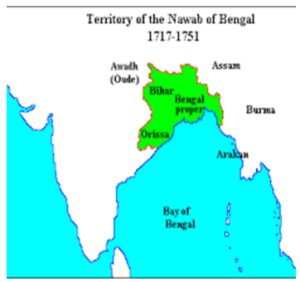
The rise of Bengal as a significant power can be traced back to the ascension of Murshid Quli Khan as the Nawab of Bengal. His reign brought about a significant rise in Bengal’s prominence and prosperity. He implemented astute administrative and economic policies that fostered growth and stability.

The Mughal conquest of Bengal occurred in several stages:
These conquests marked the incorporation of Bengal into the Mughal Empire as an important province, shaping its political and administrative structure.
Bengal was the biggest subdivision of the Mughal Empire, spanning present-day Bangladesh and West Bengal.
Following the British East India Company’s victory at the Battle of Plassey in 1757, Bengal underwent a deindustrialization process.
The rise of the autonomous state of Bengal marks a significant period in the region’s history. Here is an overview of the key events:
Under Murshid Quli Khan’s administration, the Nawab of Bengal held considerable power and authority. He established a centralised administrative structure that aimed to streamline governance and increase revenue for the state. Some key features of the administrative system during his time included:
The administrative system evolved over time, and subsequent rulers and administrators made further changes and additions to the governance structure in Bengal.
|
#PWOnlyIAS Edge |
Malzamini System And The Rise Of New Landed Aristocracy
|
This era witnessed the flourishing of trade, agriculture, and art, elevating Bengal to a position of considerable influence in the Indian subcontinent. Murshid Quli Khan’s leadership laid the groundwork for Bengal’s subsequent emergence as a formidable power in the region.
Murshid Quli Khan’s economic policies and administrative reforms played a crucial role in improving the economic condition of Bengal during his reign. The focus on revenue collection, trade promotion, agricultural development, and infrastructure contributed to the prosperity of the region and set the foundation for future economic growth.
The confrontation between the British and the Nawabs of Bengal played a significant role in the history of Bengal during the 18th century. It led to a shift in power dynamics and ultimately paved the way for British dominance in the region.
The 18th century saw substantial political, economic, and cultural changes in Bengal province. It was colonised by the British, which resulted in exploitative practices and the demise of indigenous businesses. This era saw the beginning of Bengal’s incorporation into the British Empire, laying the groundwork for future independence efforts.

<div class="new-fform">
</div>